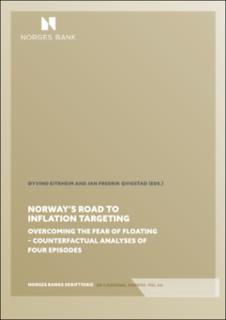| dc.description.abstract | Norway suffered from a deep recession with a systemic banking crisis in the early 1990s. The prevailing fixed exchange rate system at that time had procyclical properties. The fall of the Berlin Wall in 1989, the German reunification in the autumn of 1990 and the rebuilding of the East German Länder led to higher German interest rates. These higher interest rates put pressure upwards on the Norwegian interest rates as well and thus aggravated the Norwegian crisis. Norway changed its monetary policy regime to that of inflation targeting and flexible exchange rates around the turn of the millennium. When the financial crisis hit in 2008 and when oil prices fell in 2014, the exchange rate channel in both cases helped absorb the shock and cushion the effects on the Norwegian economy. To illustrate properties of the fixed and flexible exchange rate systems, which were in place before and after the turn of the century, respectively, we have made counterfactual analyses of four episodes. What would have happened if inflation targeting and flexible exchange rates had been introduced already in the early or mid 1990s? And, what if a fixed exchange rate regime was still in place in 2008 and 2014? We have used the macroeconomic models available in Norges Bank to conduct the aforementioned counterfactual simulations whose results are reported in Chapter 2 and 3. Chapter 2 reproduces a paper the two editors wrote already in the late 1990s based on counterfactual simulations using the bank’s main macromodel at that time, RIMINI. The results indicate how inflation targeting and flexible exchange rates might have dampened the recession in the early 1990s, allowing interest rates to be reduced during the prevailing deep recession. Chapter 3 is co-authored with Erling Motzfeldt Kravik and Yasin Mimir from the bank’s model unit and report counterfactual simulations using the bank’s current main macromodel, NEMO. The results indicate that for both episodes we have considered in the 2000s, the financial crisis in 2008 and the fall in oil prices in 2014, respectively, a return to the old fixed exchange rate regime would have incurred dramatic output costs following a substantial tightening of monetary policy in order to maintain a stable exchange rate. It should be stressed that today’s monetary policy regime works because of its established credibility and confidence in the nominal anchor, i.e. that the targeted level of inflation will be achieved in the medium term perspective. It can indeed be questioned whether such credibility was in place as early as in 1990. The accommodating policy of the devaluation decade 1976-1986 had weakened the confidence among the general public that monetary policy would deliver low and stable inflation. Thus, proposing a change in the monetary policy regime as early as in 1990 might have been interpreted as a reversion of the policy change four years earlier, and that the government, so to speak, was ”throwing the cards”. Although New Zealand as the first country had introduced inflation targeting effective from February 1990, the inflation targeting regime was in its infancy, and was yet neither well known nor well established as an alternative monetary policy regime. After all, there had been a considerable time for deliberations and for maturing the decision to move to inflation targeting in New Zealand, a process that started already in the early 1980s. Canada and Sweden followed suit and introduced inflation targeting as early as in 1991 and 1993 respectively, whereas it took another ten years before Norway introduced inflation targeting de jure in 2001. Monetary policy in a small open economy like Norway will always be constrained and the room for manoeuvre will always be limited. For example, the combination of high oil prices and low international interest rates in 2010-2014 turned out to yield procyclical outcomes, notwithstanding the fact that Norges Bank used the freedom to maintain higher interest rates than in the Eurozone. But in times of crisis Norway has been well-served by exchange rate flexibility, which made monetary policy more countercyclical when needed, thus providing important relief which helped smooth the process adapting to the global financial crisis in 2008 and the drop in oil prices in 2014. It is an open question whether the fear of floating exchange rates could have been overcome at an earlier point of time, such as in the midst of the 1990s after countries like New Zealand, Canada, Finland and Sweden had pioneered adopting inflation targeting and floating exchange rates, but the experiences from the past two decades tell us better late than never. | en_US |

